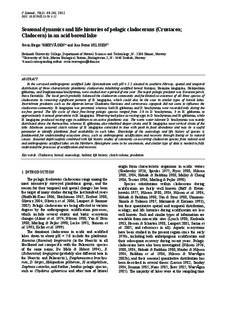| dc.description.abstract | In the surveyed anthropogenic acidified Lake Gjerstadvann with pH ≈ 5.2 situated in southern Norway, spatial and temporal
distribution of three characteristic planktonic cladocerans inhabiting acidified boreal biotopes, Bosmina longispina, Holopedium
gibberum, and Diaphanosoma brachyurum, were studied over a period of one year. The major pelagic predator was Eurasian perch,
Perca fluviatilis. The local perch probably balanced the cladoceran community and facilitated co-existence of all three species of
cladocerans by removing significant portions of B. longispina, which could also be the case in similar types of boreal lakes.
Invertebrate predators such as the dipteran larvae Chaoborus flavicans and carnivorous copepods did not seem to influence the
cladoceran community. B. longispina was perennial, whereas both H. gibberum and D. brachyurum were recorded only during the
ice-free period. The life cycle of these free-living pelagic species ranged from 2-3 in D. brachyurum, 3 in H. gibberum to
approximately 6 annual generations in B. longispina. Wintering took place as resting eggs in D. brachyurum and H. gibberum, while
B. longispina produced resting eggs in addition to an active planktonic stay. The warm water tolerant D. brachyurum was mainly
distributed above the thermocline, whereas H. gibberum also inhabited deeper strata, and B. longispina most vertical strata of the
lake. Maximum seasonal clutch volume of B. longispina coincided in time with peak in food abundance and may be a useful
parameter to identify planktonic food availability in such lakes. Knowledge of the autecology and life history of species is
fundamental for understanding ecosystem stress, such as anthropogenic acidification and recovery through liming or by natural
causes. Seasonal depth isoplots combined with life history studies of commonly co-occurring cladoceran species from natural acid
and anthropogenic acidified lakes on the Northern Hemisphere seem to be uncommon, and similar type of data is needed to fully
understand the processes of acidification and recovery. | en_US |
